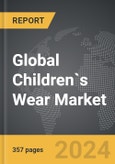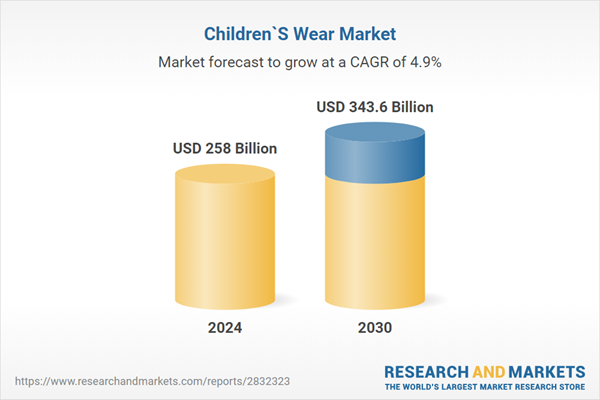The global market for Children's Wear was valued at US$258.0 Billion in 2024 and is projected to reach US$343.6 Billion by 2030, growing at a CAGR of 4.9% from 2024 to 2030. This comprehensive report provides an in-depth analysis of market trends, drivers, and forecasts, helping you make informed business decisions. The report includes the most recent global tariff developments and how they impact the Children's Wear market.
Major drivers of growth in the children's wear market include the influence of fashion trends, brand loyalty, social media, sustainability, and technological advancements. The global birth rate and rising household incomes in developing economies contribute to increased demand for children's apparel, prioritizing quality and brand reputation. Moreover, the drive towards sustainability prompts innovation in materials and manufacturing processes, while technological advancements enhance the shopping experience through AR fitting rooms and personalized e-commerce platforms.
Gender-neutral clothing, customization, and personalization are emerging trends in children's wear, reflecting societal shifts towards inclusivity and individuality. Brands are moving away from traditional gender-specific designs, offering versatile options that promote self-expression without boundaries. Customized and personalized clothing options allow parents and children to create unique garments, enhancing both style and personal connection to the clothing.
Segments: Product Segment (Girls Wear, Boys Wear, Infants & Toddlers Wear).
Geographic Regions/Countries: World; United States; Canada; Japan; China; Europe (France; Germany; Italy; United Kingdom; Spain; Russia; and Rest of Europe); Asia-Pacific (Australia; India; South Korea; and Rest of Asia-Pacific); Latin America (Argentina; Brazil; Mexico; and Rest of Latin America); Middle East (Iran; Israel; Saudi Arabia; United Arab Emirates; and Rest of Middle East); and Africa.
The analysts continuously track trade developments worldwide, drawing insights from leading global economists and over 200 industry and policy institutions, including think tanks, trade organizations, and national economic advisory bodies. This intelligence is integrated into forecasting models to provide timely, data-driven analysis of emerging risks and opportunities.
Children's Wear: Key Trends and Drivers
The children's wear market is a dynamic segment within the apparel industry, characterized by its resilience and capacity for rapid growth. Influenced by factors such as demographic shifts, changes in consumer behavior, and technological advancements, this market segment presents unique opportunities and challenges for brands and retailers. Understanding the drivers and trends shaping this industry is essential for stakeholders looking to capitalize on its potential. At present, the children's wear market is vibrant with innovation, creativity, and a touch of nostalgia, making it an exciting time for young fashion enthusiasts and their parents. Children's fashion is becoming more influenced by adult fashion trends, driven by parents' desires to dress their children in stylish, trendy outfits that reflect their own tastes. This has led to a surge in demand for mini-me clothing and designer children's wear. Brand loyalty also plays a significant role, with reputable brands seeing repeat purchases as trust and quality drive consumer preference.Major drivers of growth in the children's wear market include the influence of fashion trends, brand loyalty, social media, sustainability, and technological advancements. The global birth rate and rising household incomes in developing economies contribute to increased demand for children's apparel, prioritizing quality and brand reputation. Moreover, the drive towards sustainability prompts innovation in materials and manufacturing processes, while technological advancements enhance the shopping experience through AR fitting rooms and personalized e-commerce platforms.
Gender-neutral clothing, customization, and personalization are emerging trends in children's wear, reflecting societal shifts towards inclusivity and individuality. Brands are moving away from traditional gender-specific designs, offering versatile options that promote self-expression without boundaries. Customized and personalized clothing options allow parents and children to create unique garments, enhancing both style and personal connection to the clothing.
Report Scope
The report analyzes the Children's Wear market, presented in terms of units. The analysis covers the key segments and geographic regions outlined below.Segments: Product Segment (Girls Wear, Boys Wear, Infants & Toddlers Wear).
Geographic Regions/Countries: World; United States; Canada; Japan; China; Europe (France; Germany; Italy; United Kingdom; Spain; Russia; and Rest of Europe); Asia-Pacific (Australia; India; South Korea; and Rest of Asia-Pacific); Latin America (Argentina; Brazil; Mexico; and Rest of Latin America); Middle East (Iran; Israel; Saudi Arabia; United Arab Emirates; and Rest of Middle East); and Africa.
Key Insights:
- Market Growth: Understand the significant growth trajectory of the Girls Wear segment, which is expected to reach US$140.6 Billion by 2030 with a CAGR of a 5.1%. The Boys Wear segment is also set to grow at 4.2% CAGR over the analysis period.
- Regional Analysis: Gain insights into the U.S. market, valued at $69.0 Billion in 2024, and China, forecasted to grow at an impressive 8.2% CAGR to reach $74.1 Billion by 2030. Discover growth trends in other key regions, including Japan, Canada, Germany, and the Asia-Pacific.
Why You Should Buy This Report:
- Detailed Market Analysis: Access a thorough analysis of the Global Children's Wear Market, covering all major geographic regions and market segments.
- Competitive Insights: Get an overview of the competitive landscape, including the market presence of major players across different geographies.
- Future Trends and Drivers: Understand the key trends and drivers shaping the future of the Global Children's Wear Market.
- Actionable Insights: Benefit from actionable insights that can help you identify new revenue opportunities and make strategic business decisions.
Key Questions Answered:
- How is the Global Children's Wear Market expected to evolve by 2030?
- What are the main drivers and restraints affecting the market?
- Which market segments will grow the most over the forecast period?
- How will market shares for different regions and segments change by 2030?
- Who are the leading players in the market, and what are their prospects?
Report Features:
- Comprehensive Market Data: Independent analysis of annual sales and market forecasts in US$ Million from 2024 to 2030.
- In-Depth Regional Analysis: Detailed insights into key markets, including the U.S., China, Japan, Canada, Europe, Asia-Pacific, Latin America, Middle East, and Africa.
- Company Profiles: Coverage of players such as Benetton Group S.p.A., Carter's Inc., Esprit Holdings Limited, Fruit of the Loom Inc., Gap Inc. and more.
- Complimentary Updates: Receive free report updates for one year to keep you informed of the latest market developments.
Some of the 209 companies featured in this Children's Wear market report include:
- Benetton Group S.p.A.
- Carter's Inc.
- Esprit Holdings Limited
- Fruit of the Loom Inc.
- Gap Inc.
- Global Brands Group Holding Limited
- Hanesbrands, Inc.
- J.C. Penney Company Inc.
- Kellwood Company LLC
- KMART
- Kohls Corporation
- Macy's Inc.
- Marks & Spencer
- Mothercare Group
- OshKosh B'gosh Inc.
- Sears Holdings Corp.
- Target Corp.
- The Children's Place Retail Stores
- VF Corporation
Tariff Impact Analysis: Key Insights for 2025
Global tariff negotiations across 180+ countries are reshaping supply chains, costs, and competitiveness. This report reflects the latest developments as of April 2025 and incorporates forward-looking insights into the market outlook.The analysts continuously track trade developments worldwide, drawing insights from leading global economists and over 200 industry and policy institutions, including think tanks, trade organizations, and national economic advisory bodies. This intelligence is integrated into forecasting models to provide timely, data-driven analysis of emerging risks and opportunities.
What’s Included in This Edition:
- Tariff-adjusted market forecasts by region and segment
- Analysis of cost and supply chain implications by sourcing and trade exposure
- Strategic insights into geographic shifts
Buyers receive a free July 2025 update with:
- Finalized tariff impacts and new trade agreement effects
- Updated projections reflecting global sourcing and cost shifts
- Expanded country-specific coverage across the industry
Table of Contents
I. METHODOLOGYII. EXECUTIVE SUMMARY2. FOCUS ON SELECT PLAYERSIII. MARKET ANALYSISIV. COMPETITION
1. MARKET OVERVIEW
3. MARKET TRENDS & DRIVERS
4. GLOBAL MARKET PERSPECTIVE
UNITED STATES
CANADA
JAPAN
CHINA
EUROPE
FRANCE
GERMANY
ITALY
UNITED KINGDOM
SPAIN
RUSSIA
REST OF EUROPE
ASIA-PACIFIC
AUSTRALIA
INDIA
SOUTH KOREA
REST OF ASIA-PACIFIC
LATIN AMERICA
ARGENTINA
BRAZIL
MEXICO
REST OF LATIN AMERICA
MIDDLE EAST
IRAN
ISRAEL
SAUDI ARABIA
UNITED ARAB EMIRATES
REST OF MIDDLE EAST
AFRICA
Companies Mentioned (Partial List)
A selection of companies mentioned in this report includes, but is not limited to:
- Benetton Group S.p.A.
- Carter's Inc.
- Esprit Holdings Limited
- Fruit of the Loom Inc.
- Gap Inc.
- Global Brands Group Holding Limited
- Hanesbrands, Inc.
- J.C. Penney Company Inc.
- Kellwood Company LLC
- KMART
- Kohls Corporation
- Macy's Inc.
- Marks & Spencer
- Mothercare Group
- OshKosh B'gosh Inc.
- Sears Holdings Corp.
- Target Corp.
- The Children's Place Retail Stores
- VF Corporation
Table Information
| Report Attribute | Details |
|---|---|
| No. of Pages | 357 |
| Published | April 2025 |
| Forecast Period | 2024 - 2030 |
| Estimated Market Value ( USD | $ 258 Billion |
| Forecasted Market Value ( USD | $ 343.6 Billion |
| Compound Annual Growth Rate | 4.9% |
| Regions Covered | Global |









